What do you do when your credentials are secure but impossible to scale? When they’re verifiable, yet invisible? That’s the crossroads many teams are facing in 2025 as they rethink their reliance on Wipro’s DICE ID for digital identity and credential management.
In this blog, we’re diving into the top DICE ID alternatives for 2025, not just as software comparisons, but as tools for growth, trust, and skill validation.
We’ll also evaluate in terms of what really matters in a credentialing platform today: flexible integrations, wallet-free verification, brand visibility, scalable issuance, audit-ready security in 2025 and how to actually switch platforms without losing your mind.
Whether you're building a verified skill badge network, issuing course completion certificates, or enabling decentralized ID for your workforce, you'll find a platform built for your vision within this article, guaranteed!
If you’ve ever searched for how to issue verifiable credentials without blockchain friction, or wondered what platform supports Open Badge 2.0 with full LMS automation, or even questioned whether DICE ID is enough for enterprise-scale digital certificate programs, you're not alone. These are no longer niche questions but a common revolution of improvement that many Institutions, HR leaders, Universities, EdTech Companies, and Certification Boards are now forced to undertake, globally
Somewhere out there, a project manager just gave up on their digital-credential-research.exe spreadsheet and took a day off. Let’s not be them!
To make this a whole lot easier, we’ve done an in-depth analysis into what Wipro’s DICE ID got right, where it hit a ceiling, and how today’s best platforms including Hyperstack have evolved to take the baton further.
Let’s start with what DICE ID got right, and where it needs a little... help.
What Is Wipro DICE ID and Why Are Organizations Looking for Alternatives?
Wipro DICE ID is one of the earliest platforms to introduce decentralized identity and verifiable credentials at scale. Let’s unpack the features:
From a security and compliance standpoint, DICE ID checks many of the right boxes.
Designed to give users control over their digital records, DICE ID allows institutions to issue credentials using decentralized identifiers (DIDs), secured with blockchain-based verification. Credentials are stored in personal digital wallets, empowering recipients with ownership and portability.
Yet somehow, it feels like the dependable colleague who’s brilliant on paper but is still figuring out how to unmute themselves on Zoom!
It aligns with evolving data protection standards and helps institutions reduce dependency on centralized credentialing systems. But, it’s approach seems especially relevant for privacy-focused deployments or government-regulated sectors that many institutions find hard to justify.
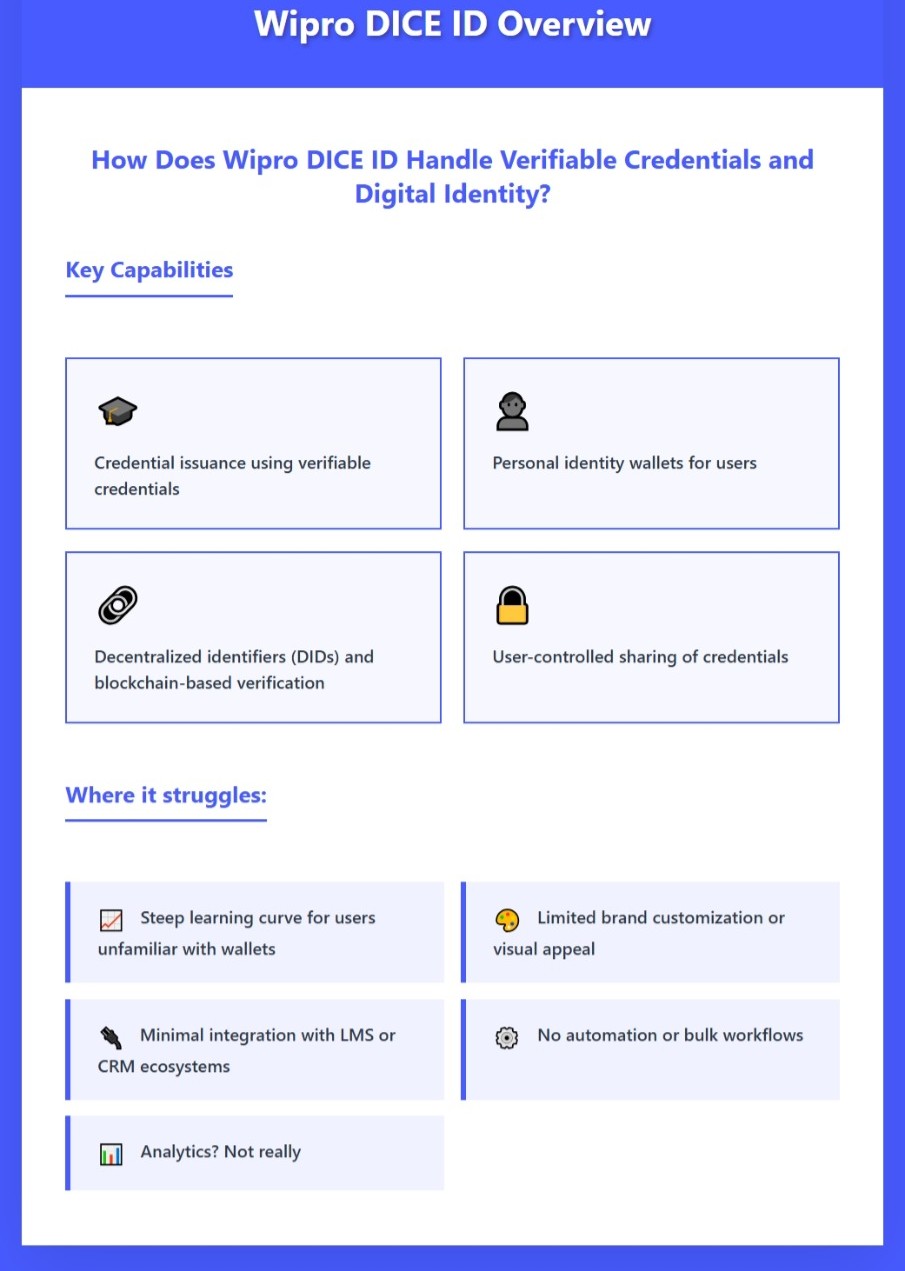
What Are the Limitations of DICE ID for Credential Issuance in 2025?
Despite its technical strengths, DICE ID presents some real-world hurdles for organizations aiming to scale their credentialing programs. The user experience, especially for recipients, can feel complicated.
Asking learners or professionals to download third-party wallet apps just to access a certificate introduces friction. And let’s be honest; most people barely want to download another food delivery app, let alone a blockchain wallet for a badge.
In terms of customization, the platform offers limited flexibility in how credentials look and feel. For organizations that rely on visual branding or want credentials to reflect their identity, this can reduce the shareability and perceived value of the badge or certificate.
Integration support is another consideration. DICE ID does not offer native connectivity with popular LMS, CRM, or HR platforms, meaning automation is minimal. Issuers may find themselves relying on manual processes, which aren't sustainable at scale.
Lastly, the platform lacks robust analytics or engagement tracking, making it hard to assess impact or adoption. You’re basically shouting into the void and hoping someone heard you.
DICE ID plays a foundational role in the digital credentialing ecosystem, but as needs evolve in 2025, many institutions are exploring tools that blend verification with usability, security with automation, and compliance with design flexibility.
Image: Feature Analysis of Wipro DICE ID and modern alternatives
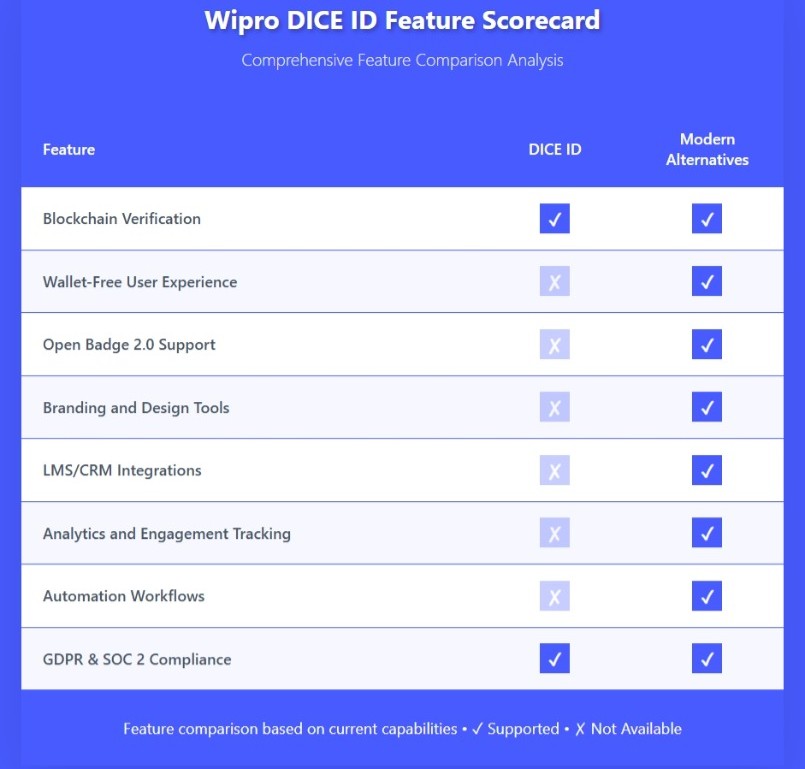
In 2025, issuing digital credentials isn’t just about security anymore. It’s about doing it in a way that makes sense for the team issuing them and the people receiving them.
Users expect instant access, simple sharing, and intuitive interfaces. And organizations? They’re looking for efficiency, automation, and measurable impact.
So what defines the “best” credentialing experience today? Platforms that support wallet-free verification, enable seamless integrations with LMS and CRMs, offer Open Badge 2.0 compatibility, and allow full control over design are taking the lead.
These features ensure that credentials aren’t just valid - they’re valuable. Hyperstack literally checks all these boxes, like a queen in the center of a chess board.
Centralized, flexible and comes with a 360 degree scope of movement.
However there are several modern solutions meeting these overall benchmarks. Among them, platforms that offer pre-built automation workflows, real-time analytics, and easy recipient access are drawing the most attention from universities, enterprises, and certification providers.
One such platform that’s been gaining momentum is Hyperstack. While it may not be the only solution, it stands out for its ability to combine flexible issuance with enterprise-grade controls and simple UX - making it a strong fit for both small teams and large networks.
Ready to issue smarter, scalable digital credentials?
See how Hyperstack compares in real time. Book a demo and explore how easy it can be to move beyond DICE ID.
Schedule Your Free Personalized Demo Now →
It’s not about picking the flashiest tool. It’s about picking the one that quietly makes everything easier.
Sometimes the best way to evaluate a platform is to hear what the switch actually looks like - not as a sales pitch, but as a reflection of changing needs.
University Use Case
A major university in Southeast Asia recently transitioned from a traditional credentialing provider to a more flexible system. Their switch was driven by a desire for wallet-free access for students, stronger design control to reflect their brand identity, and better data on how credentials were being used and shared. Within three months, they issued over 10,000 digital credentials using Open Badge 2.0, seeing a 72% increase in share rates and higher visibility for their academic programs.
Corporate L&D Team
A global learning and development team shifted to a platform that offered quick LMS integration and no-code design tools. As a result, employees adopted digital badges more enthusiastically, and internal workflows became noticeably smoother.
Bootcamp in the US
A tech bootcamp upgraded its credentialing process to make certificates more dynamic and recruiter-friendly. Completion badges now resemble mini resumes and have led to higher learner satisfaction scores.
Credential Alliances
An industry credentialing alliance streamlined their issuance with real-time APIs and better compliance tracking. Their leadership team reported stronger visibility into adoption and a reduction in administrative overhead.
Every organization’s needs are different - but many are finding value in systems that meet both enterprise goals and learner expectations without needing extensive technical lift.
Digital credentialing in 2025 is no longer about just issuing PDFs or blockchain hashes. It's about creating a trusted, engaging, scalable system that delivers value to both issuers and recipients. When evaluating a replacement for DICE ID, keep your eye on:
Wallet-free verification
No one wants to download an app just to prove they completed a webinar.
Open Badge 2.0 compliance
It's the new universal standard.
Bulk and automated issuance
Issuing one by one is fine, if you have six hours and a podcast.
Design control
If your badge looks like clipart from 2003, you’re doing it wrong.
Scalable integrations
Connect to LMS, CRM, or HR systems without developer breakdowns.
Analytics and tracking
Know who’s engaging, sharing, and verifying credentials.
Security compliance
GDPR, SOC 2, blockchain optionality.
What Are the Top Alternatives to Wipro DICE ID in 2025?
Choosing a credentialing platform today feels like ordering coffee with too many modifiers. You want the right blend of automation, security, branding, and ease of use — without ending up with something that’s all foam, no espresso.
We’ve shortlisted the top players for 2025 based on platform flexibility, feature completeness, compliance, and real-world adaptability. These aren’t just the loudest names. They’re the ones solving actual problems for issuers at scale.
1. Hyperstack
All-in-one badge and credentialing suite for enterprise, education, and credential alliances
setup fatigue, Hyperstack is one of the top contenders.
Hyperstack is often the first stop for teams moving away from DICE ID. It combines verifiable credentials, digital badge design, and enterprise-ready compliance into one seamless system.
What makes it stand out is its wallet-free verification model. Credential recipients don’t need to download an app, set up a decentralized identity wallet, or decipher blockchain jargon to access their certificates. Just a link that’s beautifully branded and instantly shareable.
Its full support for Open Badge 2.0 ensures that credentials meet modern interoperability standards. Add to that native integrations with tools like Google Workspace, Canvas, Moodle, HubSpot, and Salesforce, and you’ve got a platform that plays well with your stack.
Security? It’s SOC 2 and GDPR compliant, with detailed access logs and real-time analytics dashboards. And the design interface lets you control every pixel of your badge or certificate layout, something most platforms overlook.
If you’re looking for the best DICE ID alternative in 2025 for scaling digital credentials with brand visibility and zero setup fatigue, Hyperstack is one of the top contenders.
Hyperstack builds on the foundations DICE ID helped shape, but focuses on something most platforms overlook - user flow. From issuance to verification, everything is designed to remove friction while staying secure and scalable.
- Wallet-free access for recipients
- Blockchain-backed Open Badge 2.0 compliance
- Fully customizable badge design and certificate templates
- Native integrations with Google Workspace, major LMSs, and CRM tools
- SOC 2 and GDPR compliant by default
- Live engagement analytics and audit-friendly logs
Think of it as the one platform that doesn’t punish you for wanting nice design and tight security in the same package.
Not sure if Hyperstack fits your setup? Try issuing just five test badges, first. That usually seals the deal.
2. Accredible
Certificate-badge combo with strong automation and LMS focus
Accredible is often praised for its ability to issue digital credentials at scale with minimal fuss. Designed with educators and professional training platforms in mind, it supports PDF certificates, blockchain-verified badges, and LMS integrations out of the box.
The real magic? Credential automation. You can set triggers based on course completions, quiz scores, or event attendance, and have the credential delivered instantly. It works well with Canvas, TalentLMS, LearnDash, and other learning platforms.
The badge design tools are simple but functional. You won’t be winning any visual awards, but you’ll definitely deliver a consistent, branded experience. Their blockchain verification system adds a layer of trust, although users may still require additional steps to verify credentials if they’re unfamiliar with the interface.
For teams focused on delivering verifiable digital certificates with learning platform support, Accredible gets high marks for reliability.
Accredible is popular for good reason. It offers a solid automation suite, supports both certificates and badges, and integrates with many learning platforms.
- Blockchain support for verification
- PDF and digital badge pairing
- Simple editor for badge visuals
- Strong LMS support including Canvas, Moodle, and TalentLMS
While design flexibility is somewhat limited, Accredible shines when you want reliable delivery and easy setup. It’s a “get the job done without fuss” kind of platform.
Just don’t expect your credentials to go viral on social media; they’re more functional than flashy.
3. Credly by Pearson
Enterprise-grade platform with strong employer recognition
Credly (now part of Pearson) is built around the idea that skills credentials should translate directly to career opportunities. Their ecosystem ties together digital badges, employer validation, and HRIS integration.
What makes it unique is the use of skill taxonomies, making it easier for HR teams to interpret what a badge actually means. The platform integrates with systems like Workday, SAP SuccessFactors, and LinkedIn Talent Hub, so issued badges flow naturally into talent pipelines.
Credly badges include metadata like skills, issuing authority, and evidence links. You can also build learning pathways, stackable credentials, and automate achievement tracking; features especially useful for workforce development programs and corporate learning.
However, design options are somewhat locked down. If branding and badge aesthetics matter to your audience, this may feel like a limitation. But for enterprise digital credentialing, Credly continues to be a top choice.
- Metadata-rich badges and skill taxonomies
- Deep integrations with HRIS platforms
- Built-in pathways to job boards
- Badge stacking and achievement tracking
Customization and white-labeling are limited, but its backend is robust. For organizations looking to map learning to career outcomes, Credly makes that easier than most.
It’s the LinkedIn of credentialing. Not the coolest at the party, but everybody knows them.
4. Sertifier
Skills-first approach with analytics baked in
Sertifier approaches credentialing with a focus on skill transparency and data-driven issuance. Ideal for academic institutions, bootcamps, and training programs, it provides tools that help define and tag skills into every badge.
One of its most appreciated features is the real-time dashboard showing who opened, clicked, and shared each credential. Positively helpful when proving program impact or running A/B tests.
Sertifier supports email automation, learner insights, and bulk issuance. It integrates with platforms like Zapier, Thinkific, and Google Sheets, making it an attractive option for mid-size education providers.
The drawback? No Open Badge 2.0 support or blockchain features yet. But if you’re focused more on credential visibility, learner engagement, and analytics for digital badges, Sertifier is well worth considering.
Sertifier focuses on skill visibility and learning analytics. It’s especially appealing to training providers and educators who care about how credentials are interpreted.
- Skill tagging and metadata tools
- Dashboard insights on engagement
- Email delivery and scheduling tools
- Affordable pricing for education use
It lacks native blockchain or Open Badge 2.0 support, but makes up for it with simplicity and useful analytics. Think of it as a data-driven alternative for straightforward use cases.
You might not frame your Sertifier badge, but you’ll know exactly who clicked on it.
5. Certopus
Developer-friendly platform with a surprising amount of polish
Certopus is built with builders in mind. This is a platform where the API documentation is actually a selling point. It’s popular among teams who want to customize every part of the issuance workflow using webhooks, server triggers, or role-based access.
It supports QR code verification, secure badge distribution, and simple recipient management. While the visual customization tools aren’t as advanced as others, you can import custom templates or tweak them in code.
For teams prioritizing automated credential issuance, verifiable QR certificates, or low-code integrations, Certopus offers flexibility and control without requiring a full IT team.
It’s especially valuable in developer-heavy environments or for organizations that issue credentials across multiple verticals. So, if your tech team is involved in the credentialing process, Certopus will likely get their vote. It’s automation-heavy and designed to be API-first.
- Easy webhook setup for external systems
- Badge templates with QR code verification
- Recipient management tools and reports
- Role-based access and version tracking
Design tools aren’t as rich, but the feature stack is solid. Especially for teams who like control and want to build around the platform.
One for the tinkerers; Certopus rewards curiosity and a few lines of code.
6. Badgr
The academic favorite, especially within Canvas environments
Badgr (now a part of Concentric Sky) is practically synonymous with micro-credentials in education. It's one of the earliest adopters of the Open Badge standard and continues to support academic institutions around the world.
Its integration with Canvas LMS makes it the default for many schools, colleges, and universities. You can build learning pathways, stack achievements, and show learner progress using visual roadmaps.
While the design and branding tools are relatively limited, the platform shines in curriculum mapping, student outcomes, and formative assessment tracking.
For credentialing programs that are tightly woven into course modules or academic requirements, Badgr remains a go-to choice in 2025.
Badgr is built for educators. Its Open Badge compliance and integration with learning pathways makes it ideal for formal education programs.
- Strong focus on learning journeys and micro-credentials
- Canvas LMS integration is seamless
- Open Badge 2.0 support
- Clear progress visualization for learners
Branding is limited, and the platform isn’t ideal for cross-department or enterprise use. But for classrooms and curriculum-linked pathways, it does the job well.
If your badge says “completed all assignments,” it probably came from Badgr.
How Do You Transition Away from DICE ID Without Losing Momentum?
Migrating from a legacy credentialing system can feel like moving apartments. You know it’s time, but the logistics are… daunting. Fortunately, most modern platforms have made it easier than ever to switch.
Here’s what the typical transition looks like:
Start by downloading any data you can access like; recipient info, issue dates, and credential types.
Some platforms let you upload old credentials and maintain verifiability. Look for ones that support CSV, JSON, or API-based imports.
Retire wallet dependencies
Platforms like Hyperstack allow you to verify credentials via public links, QR codes, or embedded iframes. Wallets are optional, not mandatory.
Transfer your old certificate styles or upgrade them to modern, branded visuals.
Notify your recipients about the new platform using built-in email systems or third-party integration.
Update all verification links
Ensure every certificate or badge you’ve published (especially on your site) now redirects to the new verification page.
Bonus tip: Run a 30-day pilot with a small user group before going full scale. That way, your IT team won’t revolt.
Sure, you’ve picked a platform. But are you getting the full mileage out of it, or just cruising in first gear?
Choosing a digital credentialing solution is only half the equation. The real magic happens when you begin to unlock its full potential, i.e. - automating workflows, enriching data, customizing badge designs, and making each credential work harder than your average coffee-fueled intern.
A well-implemented system doesn’t just hand out certificates. It becomes a growth engine. That means setting up integrations that eliminate manual tasks, enabling analytics that reveal what’s working (and what’s not), and creating shareable, search-optimized credentials that promote both learner success and institutional reach.
If your badge isn’t helping you grow brand visibility, reduce admin load, and drive learner engagement, it’s probably just a fancy sticker.
And if you're still emailing PDFs manually... blink twice. We’ll send help.
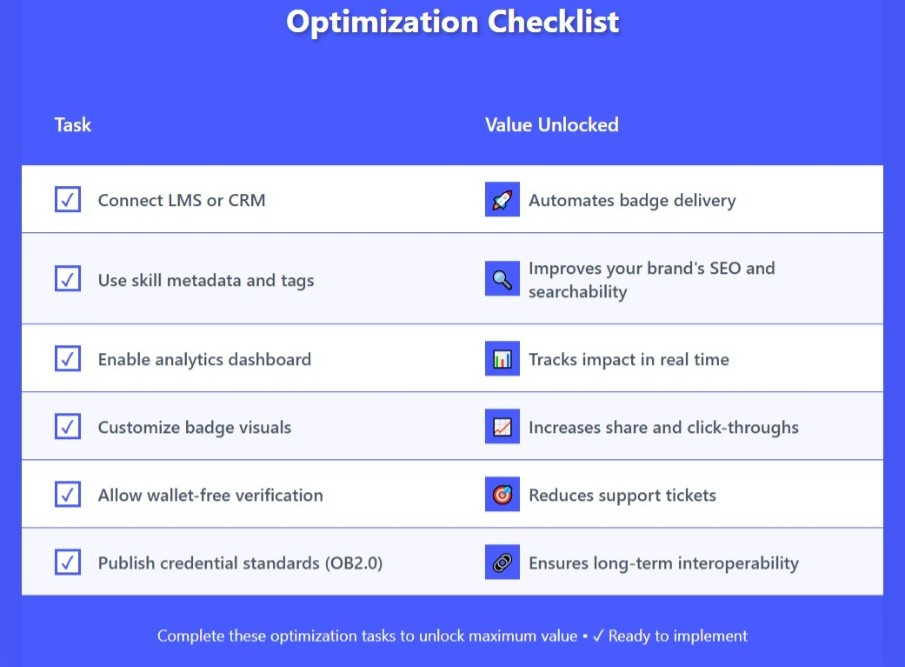
The goal isn’t just digital transformation. It’s got more to do with operational sanity.
A credentialing platform at its best should feel invisible; humming quietly in the background while your team focuses on actual learning, hiring, or certifying.
Want to know a secret? The most successful teams spend more time improving their programs than babysitting their tech stack. The platform makes that possible.
So go ahead. Let your credentialing system do the heavy lifting.
You’ve got better things to do.
What’s Next for Organizations Moving Beyond DICE ID?
The decision to move on from Wipro’s DICE ID isn’t about abandoning decentralization. It’s about evolving with it.
Organizations in 2025 are rethinking how they issue, track, and showcase credentials. Not because verification is optional, but because experience is everything. The platforms stepping up today are blending high-trust tech with the kind of usability people actually want to interact with. Less friction. More flow.
And here’s the truth no one wants to say out loud. The right platform doesn’t just meet compliance or tick features off a list. It helps you build a trusted skills ecosystem, a branded certificate library, a global talent pipeline, a recognized learning network.
Whether you're issuing credentials to 200 employees or 2 million learners, the north star is the same: verifiability with visibility, automation without complexity, and design that doesn’t scream stock image catalog from 2009.
And look, you don’t have to switch everything overnight. Migrations can be phased, APIs can do the heavy lifting, and your users don’t even have to know what blockchain is. They just need to click, view, and share.
Wouldn’t it be nice if every piece of software you used worked like that?
Your 2025 Migration Planner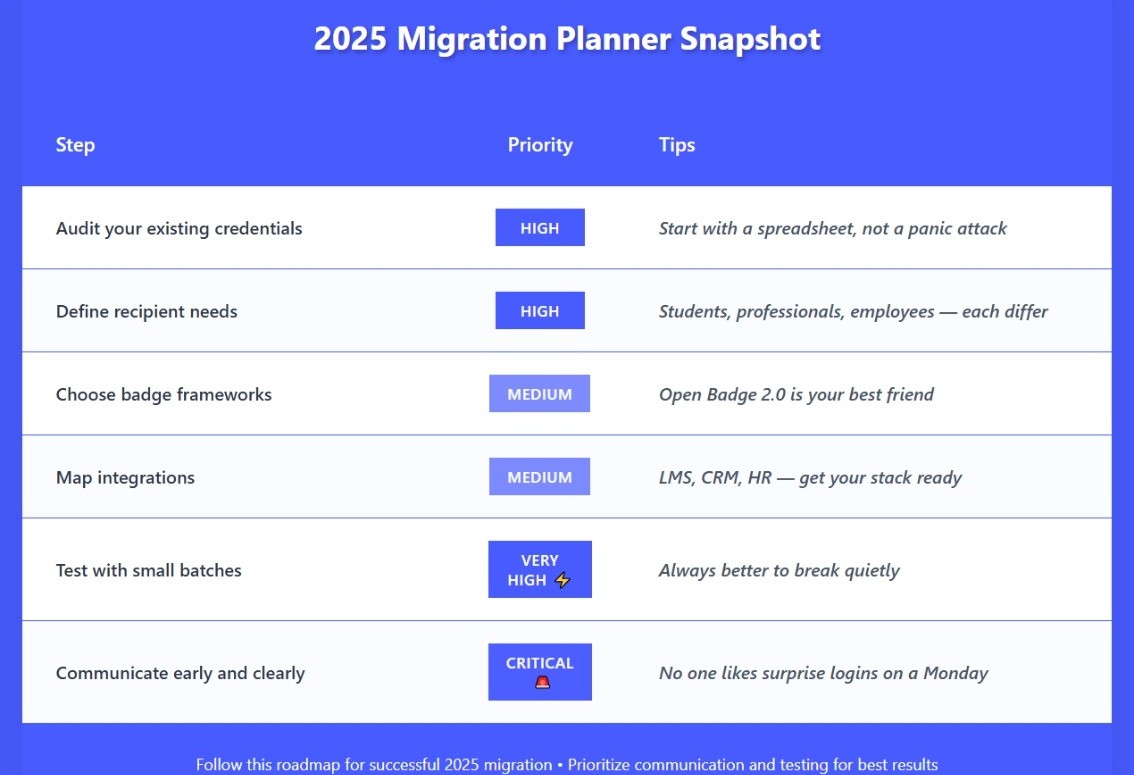
If you're already scanning platform homepages and half-comparing demo videos, you’re not alone. A lot of teams are doing the same right now — and most of them are landing on platforms that prioritize scalability and sanity in equal measure.
Hyperstack is one of them. It’s not the only tool worth checking out, but it’s become the platform many teams stay with after the switch.
And let’s face the reality;
In this world of digital identity, loyalty is earned, not assumed.
Feature-by-Feature Comparison of DICE ID Alternatives in 2025
If you’ve ever stared at five tabs open on your screen wondering which platform actually works the way you want, this is where it all becomes clear.
Sometimes the fastest way to spot the best fit is a good old-fashioned side-by-side breakdown.
Whether you're looking for Open Badge compliance, wallet-free access, or seamless LMS integration, this table puts the leading DICE ID alternatives in one glanceable view. Think of it as your shortcut to making the credentialing choice that won’t come back to haunt you in six months.
Let’s compare what really matters.
A side-by-side breakdown of the key features organizations care about most when replacing DICE ID. 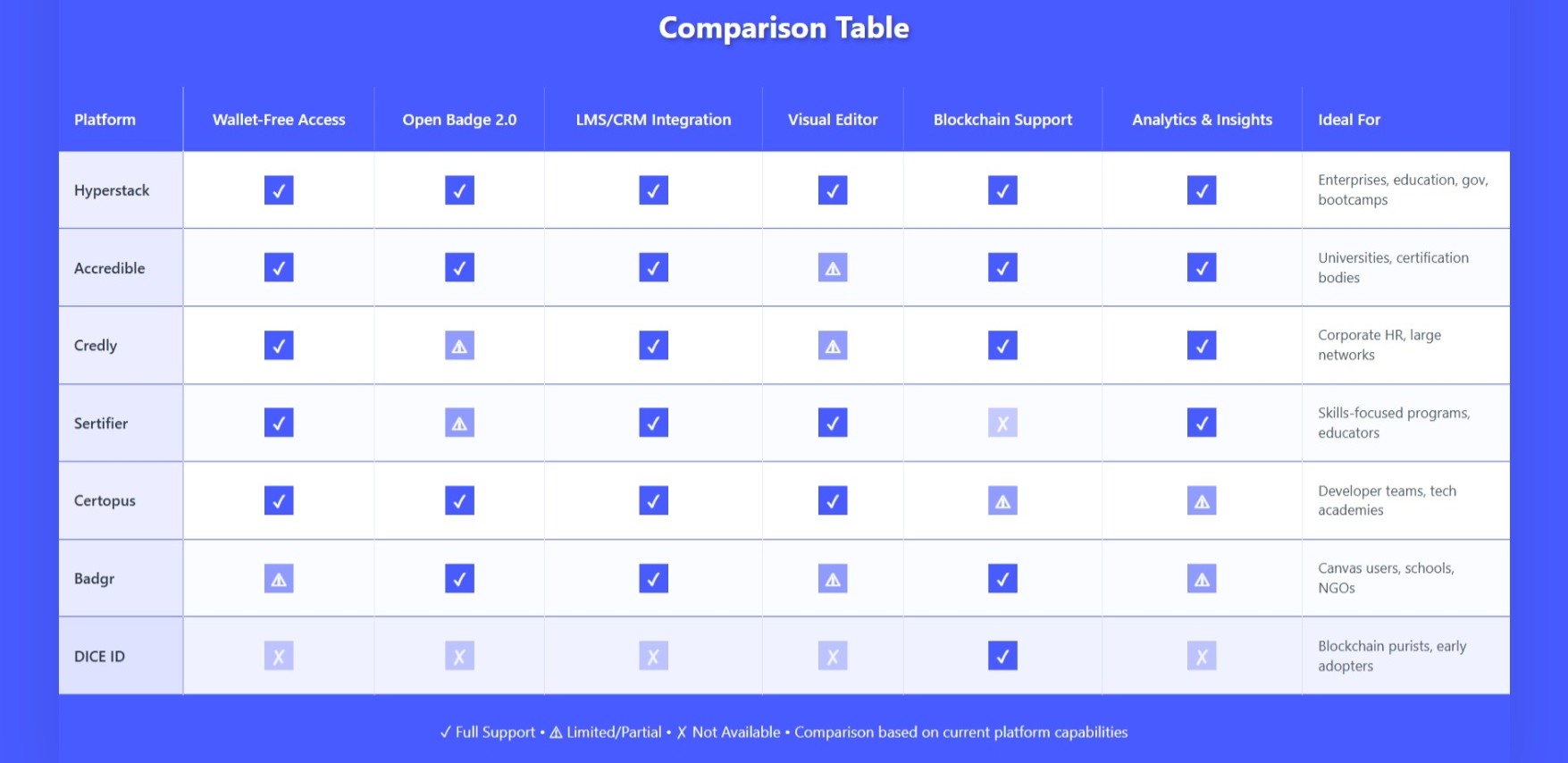
But, not all 'check' marks are created equal
This chart gives you a snapshot, but the experience behind each feature varies wildly. One platform may offer analytics through real-time dashboards, while another gives you a downloadable CSV file that feels like homework.
Likewise, LMS integration can mean anything from native one-click syncing to an API manual that makes your developer contemplate early retirement.
The key takeaway, is..
A platform that delivers automation, Design control, Open Badge compliance, and Wallet-free verification in one package is more than convenient. It’s wisely strategic. Hyperstack and a few others manage to pull this off without the technical chaos that usually comes with high-security platforms.
Final Thoughts: Choosing the Right Wipro DICE ID Alternative in 2025
You came looking for the best Wipro DICE ID alternatives, and now you’ve seen what the top digital credentialing platforms in 2025 really offer. From wallet-free verification to Open Badge 2.0 support, from visual branding to seamless LMS and CRM integrations, the space has evolved far beyond basic blockchain verification.
The smartest organizations today are no longer asking whether digital credentials matter. They’re asking how to deliver them at scale, track impact, and build trust across learners, employees, and global ecosystems. And the answer lies in platforms that are flexible, compliant, scalable, and designed with users in mind.
If you’re an enterprise looking for secure verifiable credentials, or a course creator needing automation and brand visibility, the tools are ready. Platforms like Hyperstack, Accredible, Credly, and others have already helped thousands of institutions upgrade their credentialing workflows.
So, what’s next?
Start by mapping your current needs. Do you need badge analytics? Wallet-free verification? LMS sync? Then shortlist a platform that can evolve with you and not one that locks you in.
And one last reminder before you go…
The right digital credentialing platform doesn’t just verify identities. It amplifies your impact, streamlines your process, and builds shareable proof of success.
Food for Thought: Other Articles Worth Your Scroll
- Best Credly Alternative in 2025: A Detailed Comparison for Institutions on the Lookout
- Looking beyond DICE ID? Credly often comes up next — but here's what to know before you jump.
- Top 5 Accredible Alternatives – Feature Comparison (2025)
- Accredible may be a go-to name, but how do other platforms (including Hyperstack) compare?
- Digital Credentials in Education: Tools and Strategy for 2025
- A practical look at how educational institutions are navigating modern credentialing tools.
- Digital Credentials – A Complete Guide for 2025 And Beyond
- New to digital credentials? This foundational guide gets you caught up fast.
- Badges vs Certificates in 2025: The #1 Mistake Most Institutions Still Make
- Spoiler: Not every badge is a credential. And not every certificate carries value.
- Mastering the Art of Scaling: Growing Your Online Course from 100 to 10,000 Learners
- You’ve got your credentialing sorted — now it’s time to grow.
- The Psychology Behind Pricing Online Courses: Why $199 Outsells $200
- Because even in credentialing, perception shapes value. And pricing is pure psychology.